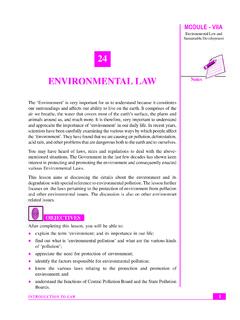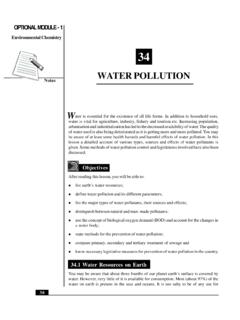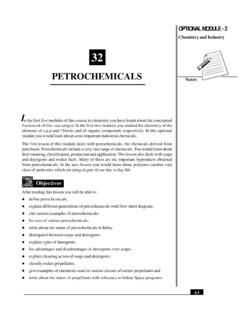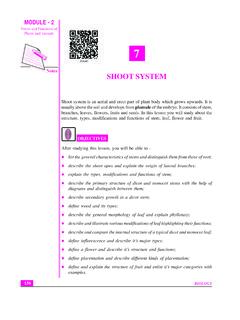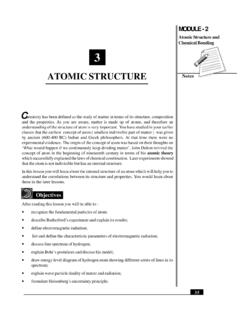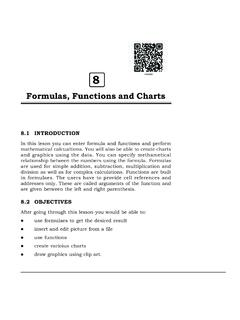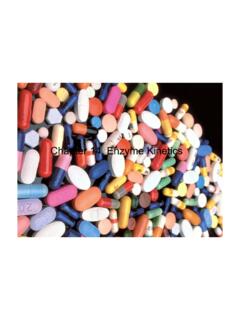Transcription of ENZYMES Notes - National Institute of Open Schooling
1 ENZYMES MODULE. Biochemistry 8. Notes ENZYMES . INTRODUCTION. The global life depends on a series of chemical reactions. Most of the chemical reactions proceed too slowly on their own to sustain life. Hence catalysts are required to greatly accelerate the rates of these chemical reactions. In nature ENZYMES posses the catalytic power to facilitate life processes in essentially all life-forms from viruses to man. Most of the ENZYMES retain their catalytic potential even after extraction from the living organism. The above catalytic power of enzyme leads to commercial usage of ENZYMES . In ancient days ENZYMES are used in manufacture of cheeses, breads, and alcoholic beverages, and for the tenderizing of meats. Today ENZYMES are also of fundamental interest in the health sciences. Human disease processes can be linked to the aberrant activities of one or a few ENZYMES .
2 Because of their role in maintaining life processes, the assay and pharmacological regulation of ENZYMES have become key elements in clinical diagnosis and therapeutics. The macromolecular components of almost all ENZYMES are composed of protein, except for a class of RNA modifying catalysts known as ribozymes. Ribozymes are molecules of ribonucleic acid that catalyze reactions on the phosphodiester bond of other RNAs. ENZYMES are found in all tissues and fluids of the body. Intracellular ENZYMES catalyze the reactions of metabolic pathways. Plasma membrane ENZYMES regulate catalysis within cells in response to extracellular signals, and ENZYMES of the circulatory system are responsible for regulating the clotting of blood. Almost every significant life process is dependent on enzyme activity. So the modern pharmaceutical research is based on the search for potent and specific inhibitors of these ENZYMES .
3 This chapter briefs you about basic nature, classification and clinical significance of ENZYMES . BIOCHEMISTRY 111. MODULE ENZYMES Biochemistry OBJECTIVES. After reading this lesson, you will be able to: z define ENZYMES z classify ENZYMES Notes z explain co- ENZYMES z explain the factors affecting enzyme activity z describe isoenzymes z explain the Clinical significance of ENZYMES DEFINITION AND CHARACTERISTICS OF. ENZYMES . ENZYMES are protein catalyst produced by a cell and responsible for the high rate' and specificity of one or more intracellular or extracellular biochemical reactions. ENZYMES are biological catalysts responsible for supporting almost all of the chemical reactions that maintain animal homeostasis. Enzyme reactions are always reversible. The substance, upon which an enzyme acts, is called as substrate. ENZYMES are involved in conversion of substrate into product.
4 Almost all ENZYMES are globular proteins consisting either of a single polypeptide or of two or more polypeptides held together (in quaternary structure) by non-covalent bonds. ENZYMES do nothing but speed up the rates at which the equilibrium positions of reversible reactions are attained. In terms of thermodynamics, ENZYMES reduce the activation energies of reactions, enabling them to occur much more readily at low temperatures - essential for biological systems. The basic characteristics of ENZYMES includes (i) Almost all the ENZYMES are proteins and they follow the physical and chemical reactions of proteins (ii) ENZYMES are sensitive and labile to heat (iii) ENZYMES are water soluble (iv) ENZYMES could be precipitated by protein precipitating agents such as ammonium sulfate and trichloroacetic acid. INTEXT QUESTIONS 1. ENZYMES are .. biocatalyst produced by cells.
5 2. ENZYMES follow physical and chemical properties of .. 112 BIOCHEMISTRY. ENZYMES MODULE. 3. ENZYMES are .. soluble. Biochemistry (a) Water (b) acid (c) organic acids 4. Precipitation of ENZYMES could be achieved by using .. and .. CLASSIFICATION OF ENZYMES . Since earlier days to still date, fanciful names such as pepsin, chymotrypsin, etc were used to name ENZYMES . Later the suffix ase to the substrate was used to Notes name ENZYMES . For example the ENZYMES lactase acts upon the lactate and produces glucose and galactose. The above method is known as trivial naming . of ENZYMES . Currently ENZYMES are grouped into six functional classes by the International Union of Biochemists and Molecular Biology (IUBMB). As per the IUBMB system, each enzyme name starts with EC (enzyme class) followed by 4 digits. The first digit represents the class, the second digit strands for the subclass, the third digit represents the sub-subclass or subgroup and the fourth digit provides the particular enzyme (Table ).
6 Table Classification of ENZYMES Classification Biochemical Properties 1. Oxidoreductases Act on many chemical groupings to add or remove hydrogen atoms. Lactate dehydrogenase 2. Transferases Transfer functional groups between donor and acceptor molecules. Kinases are specialized transferases that regulate metabolism by transferring phosphate from ATP to other molecules. Aminotransferase. 3. Hydrolases Add water across a bond, hydrolyzing it. Acetyl choline esterase 4. Lyases Add water, ammonia or carbon dioxide across double bonds, or remove these elements to produce double bonds. Aldolase. 5. Isomerases Carry out many kinds of isomerization: L to D. isomerizations, mutase reactions (shifts of chemical groups) and others. Triose phosphate isomerase 6. Ligases Catalyze reactions in which two chemical groups are joined (or ligated) with the use of energy from ATP.
7 Acetyl CoA carboxylase BIOCHEMISTRY 113. MODULE ENZYMES Biochemistry These rules give each enzyme a unique number and specifies a textual name for each enzyme. ENZYMES are also classified on the basis of their composition. ENZYMES composed wholly of protein are known as simple ENZYMES in contrast to complex ENZYMES , which are composed of protein plus a relatively small organic molecule. Complex ENZYMES are also known as holo- ENZYMES . The non- protein component of an enzyme may be as simple as a metal ion or as complex as a small non-protein organic molecule. ENZYMES that require a metal in their Notes composition are known as metalloenzymes. Metalloenzymes bind and retain their metal atom(s) under all conditions with very high affinity. ENZYMES with lower affinity for metal ion, but still require the metal ion for activity, are known as metal-activated ENZYMES .
8 Based on requirement of ATP, ENZYMES are further classified into two types namely synthetases and synthase. Synthetases are ATP- dependent ENZYMES catalyzing biosynthetic reactions. Synthetases are enzyme belong to the class 6 (Ligases). ENZYMES such as Carbamoyl phosphate synthetase, Arginino succinate synthetase and Glutamine synthetase are examples of the synthetases group of ENZYMES . The enzyme class other than ligases includes synthases. Synthases group of ENZYMES involves in catalyzing biosynthetic reactions that do not require ATP directly. ENZYMES such as glycogen synthase and Alanine synthase are examples of synthase group. INTEXT QUESTIONS 1. There are .. main groups of ENZYMES . 2. Lactate dehydrogenase is example for .. group of enzyme. 3. ENZYMES that require a metal in their composition are known as .. 4.. are ATP dependent ENZYMES .
9 5.. and .. are examples for synthase group of ENZYMES . COENZYMES. ENZYMES may be simple proteins, or complex ENZYMES . A complex enzyme contains a non-protein part, called as prosthetic group (co- ENZYMES ). Co- ENZYMES are heat stable low molecular weight organic compound. The combined form of protein and the co-enzyme are called as holo-enzyme. The heat labile or unstable part of the holo-enzyme is called as apo-enzyme. The apo-enzyme gives necessary three dimensional structures required for the enzymatic chemical reaction. Co- ENZYMES are very essential for the biological activities of the enzyme. Co- ENZYMES combine loosely with apo-enzyme and are released easily by dialysis. Most of the co- ENZYMES are derivatives of vitamin B complex 114 BIOCHEMISTRY. ENZYMES MODULE. group of substance. One molecule of the co-enzyme with its enzyme is sufficient Biochemistry to convert a large group of substrate.
10 Co- ENZYMES are further divided into two groups. The first groups of co- ENZYMES are a part of reaction catalyzed by oxidoreductase by donating or accepting hydrogen atoms or electrons. The first group of co- ENZYMES are also called as co-substrates or secondary substrates. Because they are involved in counter- balance in change occurring in the substrate. The second group of co- ENZYMES Notes involves in reactions transferring groups other than hydrogen. Role of Coenzymes The functional role of coenzymes is to act as transporters of chemical groups from one reactant to another. The chemical groups carried can be as simple as the hydride ion (H+ + 2e-) carried by NAD or the mole of hydrogen carried by FAD; or they can be even more complex than the amine (-NH2) carried by pyridoxal phosphate. Since coenzymes are chemically changed as a consequence of enzyme action, it is often useful to consider coenzymes to be a special class of substrates, or second substrates, which are common to many different holoenzymes.

